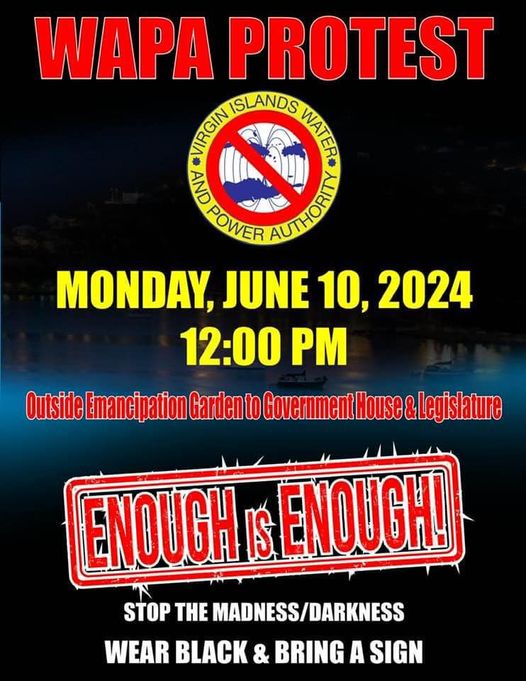CHARLOTTE AMALIE — Virgin Islands Water and Power Authority crews repaired a major transmission line in the St. Thomas-St. John District on Saturday. But rolling blackouts have continued because the plant’s largest generator remains out of service, and fed-up customers have called for a protest at noon today in Emancipation Garden on St. Thomas.
The transmission line, Feeder 13, carries power to the eastern side of St. Thomas. It failed Tuesday afternoon, setting off rotating blackouts .
Feeder 13 previously failed for a week in mid-September and again for two days in October, leaving only one functional transmission line, Feeder 12. Feeder 11 was damaged by the 2017 hurricanes and is not in service. The transmission lines are different from neighborhood distribution lines listed on feeder maps.

On Friday, WAPA released a video that showed project management director Chavante Marsh-Bultes explaining efforts to repair Feeder 13, the day after the latest blackouts began.
There are 29 manholes that allow WAPA to access the underground portion, and “one manhole was actually covered during the new Waterfront project, so it didn’t allow us access last evening to see if that was the cause of failure,” Marsh-Bultes said.
The manhole was covered by plywood set into concrete, and it’s unclear why work crews on the project were not coordinating with WAPA to ensure utility lines were left accessible for repairs. Marsh-Bultes said in the video that crews had to be careful not to further damage cables while trying to access the manhole.
Flash flooding further complicated repair efforts, and for four days, WAPA customers were forced to deal with an unpredictable, inaccurate schedule of rotating two-hour blackouts.
Feeders on St. John and the eastern side of St. Thomas would randomly go on and off without warning. At times, more than half of the district’s 22,000 customers were left in the dark, but blackouts typically affected one or two neighborhood feeders at a time, leaving around 6,000 to 8,000 customers without service.
The fault was eventually isolated, and WAPA announced Saturday that crews and contractors “have successfully completed the repairs.” But the blackouts are still continuing because plant personnel are “testing repairs on Unit 23,” which is “causing reduced generation capacity.”
The 39-megawatt GE generator first came into service in 2004, and has been a frequent cause of major power failures because of a lack of routine maintenance.
Unit 23 is the most-recently serviced generator and was last overhauled in 2017. Unit 27 generates around 26 megawatts, and Unit 15 generates around 20, and there are three 7-megawatt Wartsila generators online. Four new 9-megawatt Wartsila generators have been on island since 2021 but remained idle amid delays and payment disputes, and the WAPA board recently voted to take action that they said would enable the Wartsilas to finally be used to help the plant generate the 60 megawatts of electricity needed to meet peak demand.
Meanwhile, WAPA’s latest outage schedules still aren’t being followed, causing additional frustration for residents trying to plan when to cook, shower, and sleep. For example, Feeder 7A went out without warning at 10:30 p.m. Friday night, and was scheduled to go out between 4:30 p.m. and 6:30 p.m. Saturday, but instead went out at 7:30 p.m.
Feeder 9C in Red Hook went out at one point Sunday afternoon.
On Sunday, WAPA released yet another schedule of two-hour rotating blackouts, “due to reduced generation capacity,” and warned that “unexpected outages may still occur not related to the rotation schedule below.”
Outages in both districts have been attributed to a variety of causes, from equipment failures, to lightning, to vehicles crashing into utility poles.
One of the major issues affecting outages is the vegetation rapidly growing through WAPA’s above-ground power lines, and several recent power failures have been blamed on trees, including an outage on St. Croix’s Feeder 10B Wednesday, and another on St. Thomas’s Feeder 7A on Thursday.
In response to questions about the lack of trimming, Government House spokesman Richard Motta said that, “WAPA has personnel who deals with that. The high amount of rainfall this season has and continues to have an impact on that operation.”
But WAPA’s director of transmission and distribution, Ashley Bryan, told WAPA’s governing board on May 23 that the Authority does not have the personnel, training, or money to do routine trimming around power lines.
WAPA received a grant through the Virgin Islands Energy Office to help prevent outages, and “one of the things that we’re looking at is vegetation management, because we currently don’t have the internal ability to manage it on our own,” Bryan said. “With our system and the amount of vegetation that are in our right of ways, you need full time people that are just doing vegetation management to clear the right of ways, and we simply don’t have that.”
“Let’s talk about tree-trimmers, currently the Authority has no tree-trimming, correct? But we’ve had contracts in the past?” board member Hubert Turnbull asked.
“Yeah, so we had a contract with Asplundh to provide tree-trimming territory-wide, that contract has since ceased. Our internal linemen are trained in what’s called line clearance tree trimming, so it is not full-blown vegetation management, they are not arborists. They used to be trained as arborists, but that position was removed when the Authority did a restructuring several years ago,” Bryan said.
In order to properly manage vegetation, staff need training in more than “just simple line clearance tree trimming,” Bryan said. “There’s particular Heritage Tree Board requirements for some of the historical trees,” and they need to analyze data to properly plan where to focus efforts.
“We don’t have the staff or the equipment to be able to manage the vegetation that we have, internally. And we definitely don’t have the training that is needed for that initiative either,” Bryan said. “So, what they do is when they have an outage, they’ll do some line clearing if they can. But it’s certainly not major vegetation management.”
The St. Thomas-St. John district’s power grid operates independently from the St. Croix district, which has its own separate power plant, and suffered a similar series of blackouts in April. That prompted Governor Albert Bryan to declare a State of Emergency on April 22, which was renewed in May because of the ongoing St. Thomas-St. John blackouts, and remains in effect.
By SUZANNE CARLSON/V.I. Daily News

